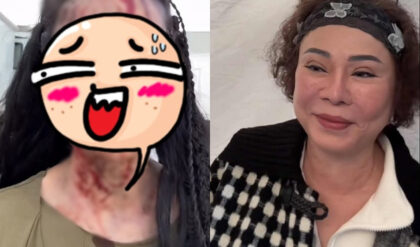Ayesha Takia, once a beloved figure in Bollywood, has been in the spotlight recently for reasons that have stirred up discussions surrounding beauty standards and the impact of cosmetic procedures. Known for her charming smile and relatable persona, Ayesha captured the hearts of many with her performances in films such as “Wanted” and “Dor.” However, her recent transformation, attributed to various cosmetic surgeries, including fillers, lip enhancements, and Botox, has left fans and followers stunned. Many are questioning the extent of these changes and their implications on her identity.
Over the years, Ayesha Takia has been candid about her journey in the film industry, often sharing insights into her life and career. Her rise to fame was meteoric, marked by her youthful looks and undeniable talent. However, as the pressures of maintaining a certain image in the limelight grew, Ayesha, like many actors, found herself navigating the often-treacherous waters of public perception and aesthetic expectations. The film industry has long been known for its emphasis on physical appearance, and Ayesha’s decisions regarding her looks are a reflection of this reality.
The shift in Ayesha’s appearance has not gone unnoticed. Photos circulating on social media platforms reveal a strikingly different version of the actress, prompting a wave of speculation and concern among her fans. The once-familiar face that graced the silver screen now appears altered, with fuller lips and a more sculpted visage. While some fans have expressed admiration for her new look, others have taken to social media to voice their concerns, questioning the need for such drastic changes. The discourse around her transformation highlights the fine line between self-expression and societal pressure to conform to certain beauty ideals.
Ayesha’s journey into cosmetic procedures began with subtle enhancements, which many celebrities undertake to maintain their youthful appearance. However, as time has passed, her transformations have become more pronounced. The use of fillers, which can enhance facial features by adding volume, has become increasingly popular among public figures. In Ayesha’s case, the changes to her cheeks and lips have sparked debates about authenticity and the pressures faced by women in the entertainment industry. Many fans are left wondering whether these alterations were a personal choice or a response to external expectations.
The discussion surrounding Ayesha’s cosmetic surgeries is indicative of a broader conversation about beauty standards in contemporary society. The pressures to look a certain way can be overwhelming, particularly for women in the public eye. The rise of social media has intensified these pressures, creating a culture where appearance is often prioritized over substance. Ayesha’s transformation serves as a reminder of how societal norms can shape individual choices, leading to a cycle of comparison and self-doubt. In an industry that thrives on youth and beauty, the desire to conform can lead many to pursue drastic measures to achieve an idealized version of themselves.
As the conversation around Ayesha’s new look continues, it raises questions about the implications of cosmetic surgery on mental health and self-image. While some individuals feel empowered by their transformations, others may find themselves grappling with feelings of inadequacy or regret. The pursuit of beauty can become a double-edged sword, offering temporary satisfaction while also fostering a sense of disconnection from one’s true self. Ayesha’s experience serves as a case study for the emotional complexities that accompany the decision to undergo such procedures.
The shift in Ayesha Takia’s appearance has also sparked discussions about the role of influencers and celebrities in shaping beauty standards. As a public figure, Ayesha’s choices have the potential to influence her audience, particularly young women who look up to her. The visibility of cosmetic procedures in the entertainment industry can perpetuate unrealistic expectations, leading fans to believe that such transformations are necessary for success and acceptance. This can create a culture of comparison, where individuals feel pressured to alter their appearance to fit a certain mold.
While some may argue that cosmetic surgery is a personal choice and a form of self-expression, it is essential to acknowledge the societal context in which these decisions are made. The entertainment industry often promotes a narrow definition of beauty, one that is heavily influenced by trends and popular culture. Ayesha’s transformation is a reflection of this reality, prompting a critical examination of the standards that dictate how women, in particular, are perceived and valued. This discourse is vital in understanding the long-term impact of beauty ideals on self-esteem and body image.
Ayesha has also faced criticism for her choices, with many fans expressing disappointment that she has altered her natural beauty. This backlash highlights the often contradictory nature of public opinion regarding cosmetic enhancements. While some people support the idea of self-improvement, others lament the loss of authenticity that can accompany such changes. Ayesha’s situation exemplifies the fine balance that public figures must navigate between personal agency and societal expectations. The scrutiny she faces underscores the challenges that many celebrities encounter when making choices about their appearance.
In recent years, Ayesha has taken a step back from the film industry, opting for a more private life. This decision has allowed her to focus on her family and personal interests, but it has not shielded her from public scrutiny. The renewed interest in her
Watch video:





